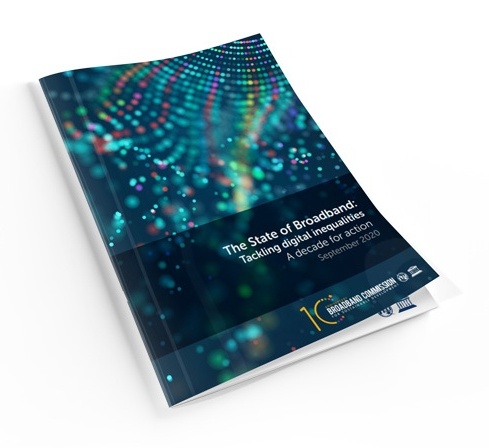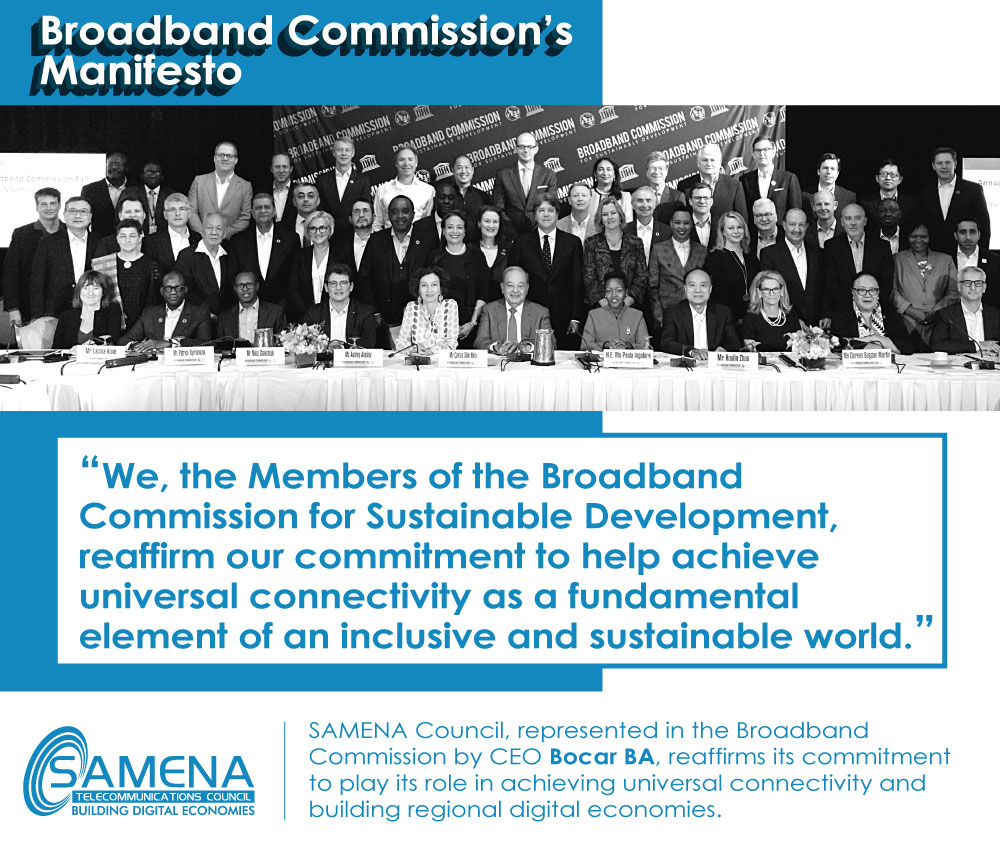The State of Broadband in 2020
 View Report
View Report
View Recommendations
This report has been written collaboratively, drawing on insights and contributions from Commissioners and their organizations, including Mr. Bocar BA, CEO of SAMENA Telecommunications Council.
The world in 2020 is in a state of flux. While much progress has been made globally over the past ten years in expanding access to, and adoption of, broadband infrastructure and services, significant challenges remain in tackling digital inequalities, addressing the current widespread impacts of the COVID-19 pandemic, and in accelerating efforts towards achieving the Sustainable Development Goals (SDGs) by 2030.
After a decade of high-level advocacy, policy recommendations, numerous working groups with research reports, and the incubation of several significant partnerships, the Broadband Commission is one of the leading global advocacy groups working towards universal broadband connectivity to ensure that the broadband ecosystem is being leveraged for broader development underpinning the SDGs.
Much work remains. Digital inequalities and uneven access and adoption of the Internet is prevalent not only between countries, but also within countries. These inequalities existed before the current crisis, and the COVID-19 pandemic has further highlighted the disparities in access to high-speed connectivity and online safety issues as many, if not most, adults and children on the planet in some way shifted towards remote work, learning, and communication activities.
The broadband ecosystem has the opportunity to play a positive role in society and economies, strengthening infrastructure, institutions, and systems that not only address the current challenges posed by the COVID-19 pandemic, but also prepare the world for future disasters. Building back better with broadband, preparing against future shocks, and ensuring universal equitable access is part of the new normal will require an emphasis on digital infrastructure and technologies in the pandemic response, recovery, and resiliency-building efforts.
Accelerating Action for the Next 10 Years of ICT Development
Policy Recommendations by the UN Broadband Commission
The world in 2020 is in a state of unprecedented flux because of the COVID-19 pandemic. The broadband ecosystem has proven its scalability and resilience to keep health, education and financial systems, and whole economies, operating. Once again broadband has demonstrated its essential role in fueling the achievement of the SDGs. But COVID-19 also uncovered how the lack of connectivity especially among marginalized communities is widening the gap between rich and poor, and further growing the digital divide. Building back better and faster with broadband will require an emphasis on digital infrastructure and technologies in the pandemic response, recovery, and resiliency-building efforts to prepare against such future shocks, but more importantly to spur achievement of the SDGs.
Today, 174 countries worldwide have a broadband plan of some sort, with several countries currently in the process of adopting one. As the UN Secretary-General has called on all sectors of society to mobilize for a decade of action towards meeting the Sustainable Development Goals, expanding broadband infrastructure and ensuring universal access to the connectivity ecosystem is critical for the global community to make progress towards the SDGs. Some countries have successfully implemented a number of policy reforms echoed by the Broadband Commission. However, opportunity remains for countries, including in the SA-ME-NA region to further their efforts to improve the broadband ecosystem in their countries by continuing to adopt more of the recommendations put forth by the Commission, with a focus on implementation.
 View Manifesto
View Manifesto
The following Policy Recommendations are the range of unique messaging adapted from the contribution from Commissioner Bocar BA in his proposed advocacy plan for the Broadband Commission.
- Implement new approaches and frameworks for spectrum allocation and licensing
- Use of universal service funds to develop broadband
- Update ICT regulations to promote more investment and market approaches for sustainability
- Merge regulation and convergent services
- Lower taxations and duties
- Make broadband affordable by adopting appropriate policy and regulation
- Foster locally relevant content creation and local hosting
- Promote free flow of data
- Implement e-government initiatives
- Monitor and collect reliable ICT data
- Build human digital capacity and skills to help users, SMEs and public sector agencies make the most of digital opportunities
- Consider and, if appropriate, apply open access approaches to infrastructure
- Undertake public consultations on policy and regulation
- Incentivize and accelerate broadband investment
- Foster digital innovation by preserving intellectual property (IP) rights
- Improve IoT and Smart City policy frameworks
- Incentivize PPP
- Promote advanced market commitments for rural broadband access
- Identify champions or leaders in broadband to mobilize political and technology support
- Improve right-of-way regulations
- Encourage e-business and entrepreneurship
- Support efforts to provide broadband connectivity to refugees and displaced individuals
- Include in broadband plans efforts on digital inclusion, measures to protect children online, a focus on limiting environmental impacts and addressing climate, and public access initiatives
- Expand initiatives to map network coverage and infrastructure needs, to develop priority lists for investment
- Integrate gender in national broadband plans and strategies and undertake action plans to advance gender equality in access to broadband
- Boost affordability and usability of broadband-enabled products and services, with a focus on addressing barriers faced by those at risk of being left behind
While 174 countries now have a national broadband plan, more work must be done to monitor and evaluate the current state of implementation of these national plans. In some cases, even after publishing and endorsing a national plan, government transitions and competing priorities lead to situations where national plans are no longer effectively being implemented and/or targets need to be revised in order to have impact on broadband adoption. Ensuring that national broadband plans are designed to increase network availability, affordability, safety and broadband adoption requires plans that are multifaceted, incorporating many, if not all, of the recommendations that the Commission has been advocating. To implement the above Policy Recommendations, countries will need to adopt various approaches to funding these plans ranging from dedicated funds, to universal service funds, direct government subsidies and grants, government equity and debts to public-private partnerships. It will also be essential to look into the next century financing and funding models for infrastructure development, and also to look into Artificial Intelligence as a catalyst for broadband development, particularly in the provision of healthcare solutions.